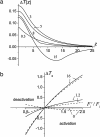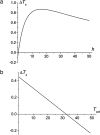Theoretical model of temperature regulation in the brain during changes in functional activity
- PMID: 16880401
- PMCID: PMC1567709
- DOI: 10.1073/pnas.0604376103
Theoretical model of temperature regulation in the brain during changes in functional activity
Abstract
The balance between metabolic heat production, heat removal by blood flow, and heat conductance defines local temperature distribution in a living tissue. Disproportional local increases in blood flow as compared with oxygen consumption during functional brain activity disturb this balance, leading to temperature changes. In this article we have developed a theoretical framework that allows analysis of temperature changes during arbitrary functional brain activity. We established theoretical boundaries on temperature changes and explained how these boundaries depend on physiology (blood flow and metabolism) and external (heat exchange with the environment) experimental conditions. We show that, in regions located deep in the brain, task performance should be accompanied by temperature decreases in regions where blood flow increases (activated regions) and by temperature increases in regions where blood flow decreases (deactivated regions). The sign of temperature effect may be reversed for superficial cortex regions, where the baseline brain temperature is lower than the temperature of incoming arterial blood due to the heat exchange with the environment. Importantly, due to heat conductance, the temperature effect is not localized to the activated region but extends to a surrounding tissue at rest over the distances regulated by the temperature-shielding effect of blood flow. This temperature-shielding effect quantifies the means by which cerebral blood flow prevents "temperature perturbations" from propagating away from the perturbed regions. For small activated regions, this effect also substantially suppresses the magnitude of the temperature response, making it especially important for small animal brains.
Conflict of interest statement
Conflict of interest statement: No conflicts declared.
Figures



Similar articles
-
Coupling between changes in human brain temperature and oxidative metabolism during prolonged visual stimulation.Proc Natl Acad Sci U S A. 2000 Jun 20;97(13):7603-8. doi: 10.1073/pnas.97.13.7603. Proc Natl Acad Sci U S A. 2000. PMID: 10861022 Free PMC article.
-
Thermodynamic constraints on neural dimensions, firing rates, brain temperature and size.J Comput Neurosci. 2009 Dec;27(3):415-36. doi: 10.1007/s10827-009-0153-7. Epub 2009 May 5. J Comput Neurosci. 2009. PMID: 19415477
-
Decreases of local brain temperature due to convection (local brain blood flow) and increases of local brain temperature due to activity.Acta Biol Med Ger. 1976;35(7):935-41. Acta Biol Med Ger. 1976. PMID: 1015165
-
Functional role of peripheral vasoconstriction: not only thermoregulation but much more.J Integr Neurosci. 2021 Sep 30;20(3):755-764. doi: 10.31083/j.jin2003080. J Integr Neurosci. 2021. PMID: 34645109 Review.
-
Brain temperature: from physiology and pharmacology to neuropathology.Handb Clin Neurol. 2018;157:483-504. doi: 10.1016/B978-0-444-64074-1.00030-6. Handb Clin Neurol. 2018. PMID: 30459022 Review.
Cited by
-
Long-wave infrared functional brain imaging in human: a pilot study.Open Neuroimag J. 2013;7:1-3. doi: 10.2174/1874440001307010001. Epub 2013 Jan 16. Open Neuroimag J. 2013. PMID: 23400426 Free PMC article.
-
Arterial CO2 Fluctuations Modulate Neuronal Rhythmicity: Implications for MEG and fMRI Studies of Resting-State Networks.J Neurosci. 2016 Aug 17;36(33):8541-50. doi: 10.1523/JNEUROSCI.4263-15.2016. J Neurosci. 2016. PMID: 27535903 Free PMC article.
-
Constancy and trade-offs in the neuroanatomical and metabolic design of the cerebral cortex.Front Neural Circuits. 2014 Feb 11;8:9. doi: 10.3389/fncir.2014.00009. eCollection 2014. Front Neural Circuits. 2014. PMID: 24574975 Free PMC article. Review.
-
MR Thermometry in Cerebrovascular Disease: Physiologic Basis, Hemodynamic Dependence, and a New Frontier in Stroke Imaging.AJNR Am J Neuroradiol. 2020 Apr;41(4):555-565. doi: 10.3174/ajnr.A6455. Epub 2020 Mar 5. AJNR Am J Neuroradiol. 2020. PMID: 32139425 Free PMC article. Review.
-
Temperature-Dependent Aggregation of Tau Protein Is Attenuated by Native PLGA Nanoparticles Under in vitro Conditions.Int J Nanomedicine. 2025 Feb 14;20:1999-2019. doi: 10.2147/IJN.S494104. eCollection 2025. Int J Nanomedicine. 2025. PMID: 39968061 Free PMC article.
References
-
- Swan H. Thermoregulation and Bioenergetics. New York: Elsevier; 1974.
-
- Holdcroft A. Body Temperature Control. London: Bailliere Tindall; 1980.
-
- Mackowiak P. A., editor. Fever: Basic Mechanisms and Management. 2nd Ed. Philadelphia: Lippincott; 1997. p. 506.
-
- Maier C. M., Steinberg G. K. Hypothermia and Cerebral Ischemia: Mechanisms and Clinical Applications. Totowa, NJ: Humana; 2004. p. 188.
-
- Serota H. M., Gerard R. W. J. Neurophysiol. 1938;1:115–124.
Publication types
MeSH terms
Substances
Grants and funding
LinkOut - more resources
Full Text Sources
Other Literature Sources

